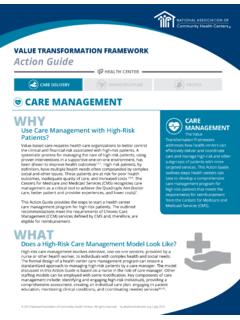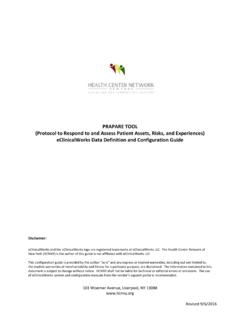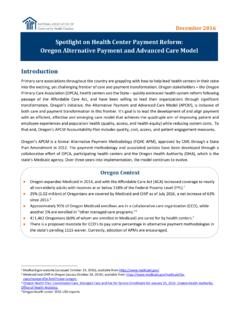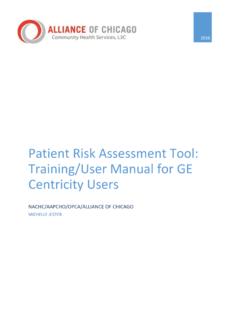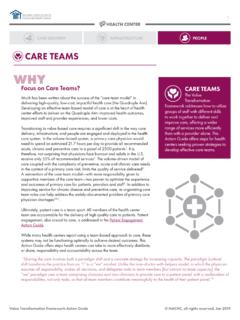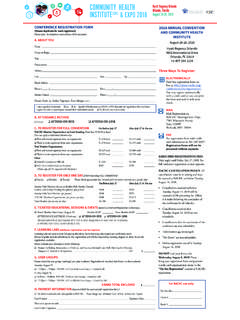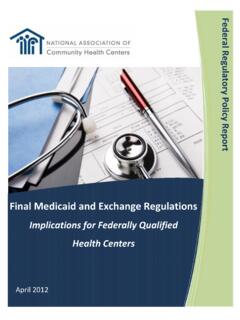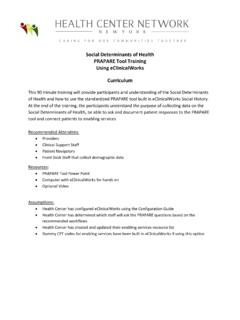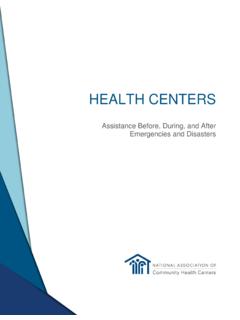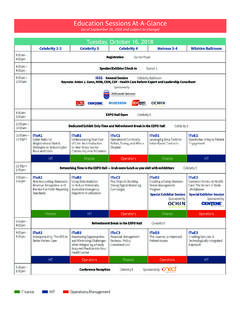Transcription of COMMUNITY HEALTH CENTER CHART - nachc.org
1 COMMUNIT Y HEALTH . CENTER CHART . June 2018. About COMMUNITY HEALTH Centers The National Association of COMMUNITY HEALTH Centers (NACHC) is pleased to present COMMUNITY HEALTH CENTER Chartbook, an overview of the HEALTH CENTER Program and the communities they serve. HEALTH centers began over fifty years ago as part of President Lyndon B. Johnson's War on Poverty. Their aim then, as it is now, is to provide affordable, high quality, comprehensive primary care to medically underserved populations, regardless of their insurance status or ability to pay for services. A growing number of HEALTH centers also provide dental, behavioral HEALTH , pharmacy, and other important services. No two HEALTH centers are alike, but they all share one common purpose: to provide primary and preventive HEALTH care services that are coordinated, culturally and linguistically competent, and COMMUNITY -directed.
2 HEALTH centers play a critical role in the HEALTH care system, delivering care to over 27 million* people today. Across the country, HEALTH centers produce positive results for their patients and for the communities they serve. They stand as evidence that communities can improve HEALTH , reduce HEALTH disparities, and deal with a multitude of costly and significant public HEALTH and social problems including substance use disorder, mental illness, natural disasters, and homelessness if they have the resources to do so. Federal and state support, along with adequate third party reimbursement, are critically important to keep pace with escalating HEALTH care needs and rising costs among populations served by HEALTH centers. Who HEALTH centers serve, what they do, and their impressive record of accomplishment in keeping communities healthy are represented in this chartbook.
3 * Includes patients of federally-funded HEALTH centers, non-federally funded HEALTH centers ( HEALTH CENTER look-alikes ), and expected patient growth for 2017. About this Chartbook The COMMUNITY HEALTH CENTER Chartbook highlights data from and research findings on HEALTH CENTER Program Grantees, as well as other Federally-Qualified HEALTH Centers (FQHCs). In this document, unless otherwise noted, the term HEALTH CENTER is generally used to refer to organizations that receive grants under the HEALTH CENTER Program as authorized under section 330 of the Public HEALTH Service Act, as amended (referred to as grantees ). Data and research sources can be found at the bottom of each figure. Most slides draw from the Uniform Data System (UDS). maintained by the Bureau of Primary HEALTH care , HRSA, DHHS.
4 UDS data included in this chartbook are limited to HEALTH centers that meet the federal grant requirements and receive federal funding from the Bureau of Primary HEALTH care . For more information about UDS data, visit Table of Contents: Section 1: Who HEALTH Centers Serve HEALTH Centers Serve . HEALTH Centers Serve Many Special Populations HEALTH Centers Serve Disproportionate Amounts of Special Populations HEALTH CENTER patients are Predominately Low-Income Most HEALTH CENTER patients are Publicly Insured or Uninsured HEALTH CENTER patients ' HEALTH Insurance Coverage is Unique Among Ambulatory care Providers HEALTH Centers Serve More Medicare & Medicaid Dual Eligibles than Other Ambulatory care Providers HEALTH CENTER patients are Disproportionately Poor, Uninsured & Publicly Insured HEALTH CENTER patients are Disproportionately Members of Racial & Ethnic Minority Groups Most HEALTH CENTER patients are Members of Racial/Ethnic Minority Groups Many HEALTH CENTER patients Suffer from Chronic Conditions HEALTH Centers Serve patients Throughout the Life Cycle Section 2.
5 Expanding Access to care Number of Federally-Funded HEALTH CENTER Organizations, 2016. HEALTH CENTER Grantee Organizations & Sites, 2007 2016. HEALTH CENTER patients & Visits, 2007 2016. HEALTH Centers Have Expanded Their Breadth of Services Available to patients Table of Contents: Section 2: Expanding Access to care (Continued). HEALTH CENTER Have Expanded Their Capacity to Provide More Services Onsite HEALTH Centers Have Higher Rates of Accepting New patients Compared to Other Providers The Number of HEALTH CENTER patients in Poverty is Growing Faster than the Number in Poverty Nationally, 2006 2016. The Number of HEALTH CENTER Medicaid patients is Growing Faster than the Number of Medicaid Beneficiaries Nationally, 2007 2016. Percent of Medicaid Beneficiaries Served by HEALTH Centers, 2016. HEALTH CENTER patients by Insurance Status, 2007 2016.
6 Even as More patients Receive Insurance, HEALTH Centers are Serving More of the Nation's Uninsured Percent of Uninured Population Service by HEALTH Centers, 2016. Federal HEALTH CENTER Appropriation History, FY2009 FY2019. Section 3: High Quality care & Reducing HEALTH Disparities Many HEALTH CENTER Exceed HEALTH People 2020 Goals HEALTH CENTER patients are More Satisfied with the Overall care Received Compared with Low-Income patients Nationally HEALTH Centers Exceed Medicaid Managed care Organization High Performance Benchmark Scores HEALTH CENTER patients Have Higher Rates of Diabetes & Blood Pressure Control than the National Average Table of Contents: Section 3: High Quality care & Reducing HEALTH Disparities (Continued). HEALTH Centers Provide More Preventive Services than Other Primary care Providers HEALTH Centers Reduce Disparities in Hypertension Treatment HEALTH CENTER Women Needing Mammograms are More Likely to Receive Them than Their Counterparts Nationally HEALTH CENTER Women Needing Pap Smears are More Likely to Receive Them than Their Counterparts Nationally HEALTH CENTER patients Needing Colorectal Cancer Screenings Are Often More Likely to Receive Them than Their Counterparts Nationally HEALTH CENTER patients Have Lower Rates of Low Birth Weight than Their Counterparts HEALTH CENTER patients Have Fewer Low Birth Weight Babies than the Average HEALTH Centers Perform Better on Ambulatory care Quality Measures than Private Practice Physicians Percent of HEALTH Centers with Patient-Centered Medical
7 Home Recognition, December 2017. Section 4: cost Effective care HEALTH Centers' Average Daily cost Per Patient Is Lower than Other Physician Settings HEALTH Centers Save $1,263 (or 24%) Per Patient Per Year HEALTH Centers Save 35% Per Child Compared to Other Providers Table of Contents: Section 4: cost Effective care (Continued). HEALTH Centers Save 24% Per Medicaid Patient Compared to Other Providers HEALTH Centers Have Lower Total Spending Per Medicaid Patient Compared to Other Providers HEALTH CENTER Medicaid Revenues as a Percent of Total Medicaid Expenditures, 2016. Medicare Spending is Lower in Areas Where HEALTH Centers Serve More Low-Income Residents HEALTH Centers are Associated with Lower Total Costs of care for Medicare patients Compared to Other Providers Section 5: HEALTH CENTER Services & Staffing HEALTH CENTER care Team Staff Provide a Broad Array of Services HEALTH CENTER Medical Services Staff, 2016.
8 HEALTH CENTER Enabling Services & Other Programs Staff, 2016. HEALTH CENTER Dental Staff, 2016. HEALTH CENTER Behavioral HEALTH Staff Growth in HEALTH CENTER Medical Providers, 2007 2016. HEALTH Centers are Hiring Non-Physician Providers at Higher Rates than Physicians Percent of HEALTH Centers Offering Case Management Services Onsite, 2016. Percent of HEALTH Centers Offering Behavioral HEALTH Services Onsite, 2016. Table of Contents: Section 5: HEALTH CENTER Services & Staffing (Continued). HEALTH Centers Have Responded to an Increasing Need for Substance Use Disorder Treatment & Therapy by Building Their Capacity & Integrating care HEALTH Centers Have Responded to an Increasing Need for Substance Use Disorder Treatment & Therapy by Seeing More patients Percent of HEALTH Centers Offering Dental Services Onsite, 2016.
9 Percent of HEALTH Centers Offering Vision Services Onsite, 2016. Percent of HEALTH Centers Offering All 5 Services Onsite, 2016. HEALTH Centers are Using Telehealth to Expand Services That May Not be Readily Available In their Locality Percent of HEALTH Centers Using Telehealth, 2016. Percent of HEALTH Centers Using Telehealth for Behavioral HEALTH Services, 2016. Percent of HEALTH Centers Using Telehealth for Primary care Services, 2016. Percent of HEALTH Centers Using Telehealth for Specialty Services, 2016. Percent of HEALTH Centers Using Telehealth to Manage patients ' Chronic Conditions, 2016. Percent of HEALTH Centers Using Telehealth for Services Other than Primary care , Specialty care , Behavioral HEALTH , or Monitoring patients ' Chronic Conditions, 2016. Percent of HEALTH Centers Using Telehealth for Two or More Service Types, 2016.
10 Table of Contents: Section 6: Challenges in Meeting Demand for care Payments from Third Party Payers are Less than cost HEALTH CENTER Funding Per Uninsured Patient Is Well Below Total Per Patient cost HEALTH CENTER Operating Margins are Less than Hospital Operating Margins Thirty-Three States Provided Funding to HEALTH Centers in State Fiscal Year 2017. Estimated Percent of County Residents Experiencing Shortages of Primary care Physicians, 2013. HEALTH Centers Experience Difficulty Recruiting Many Clinical Staff HEALTH Centers Have Unique Challenges in Recruiting & Retaining Staff HEALTH CENTER Capital Project Plans & Funding Needs, 2015. Section 1. Who HEALTH Centers Serve Figure HEALTH Centers Serve . Sources: NACHC, 2017. Based on 2016 Uniform Data System data on federally-funded and look-alike HEALTH centers, estimates for annual patient growth, and national data sources.
